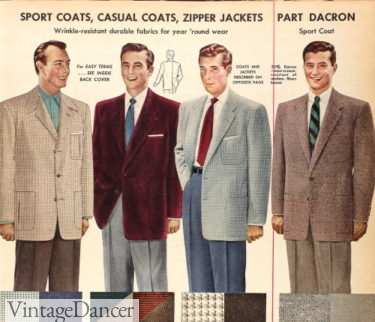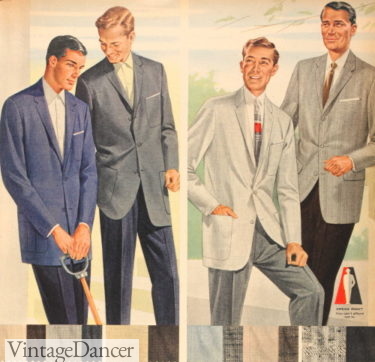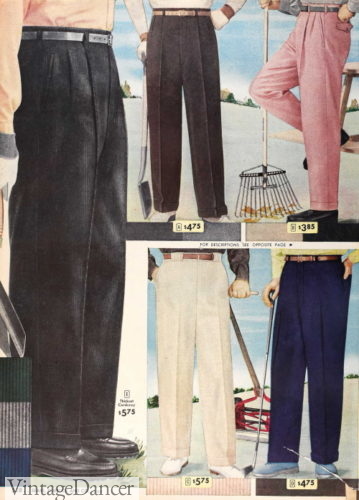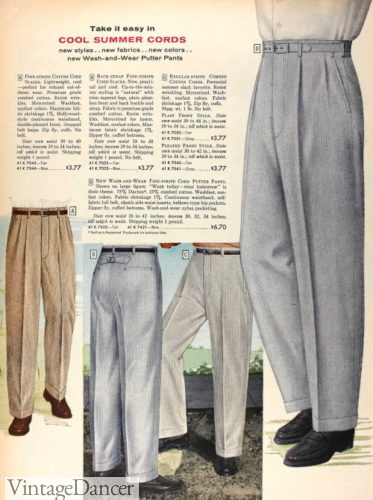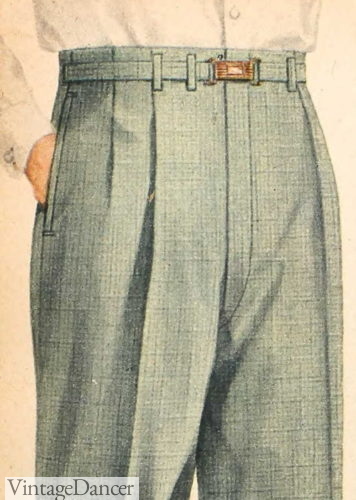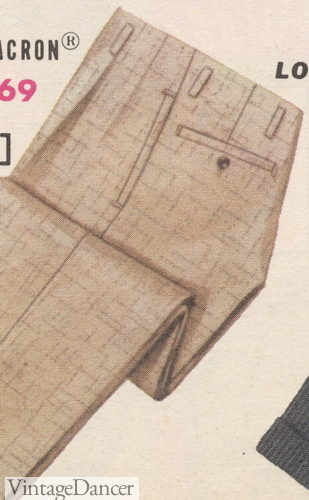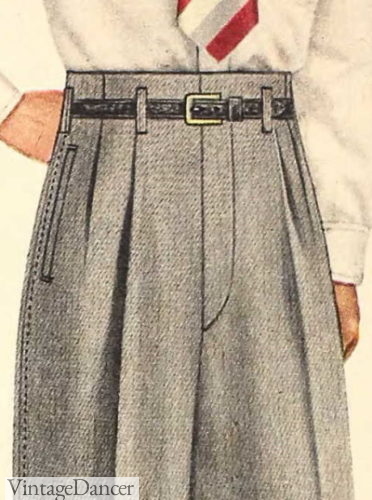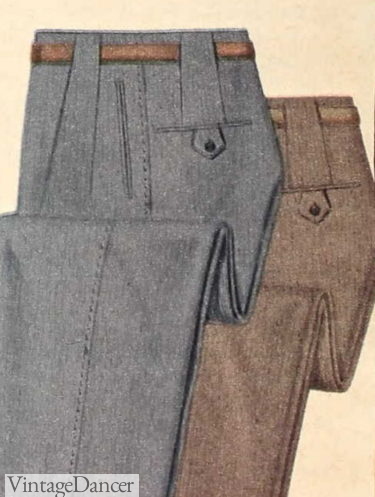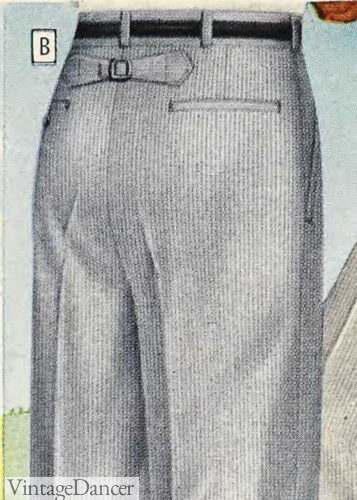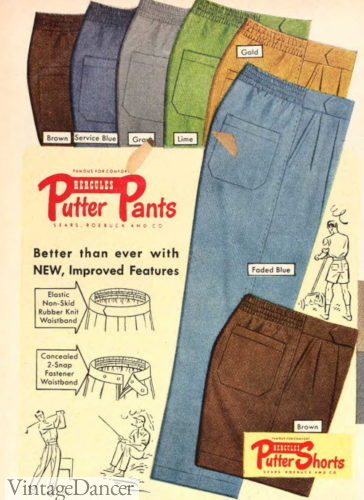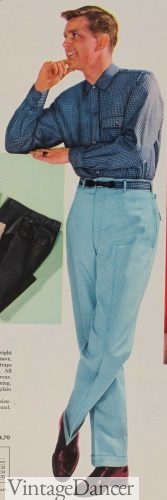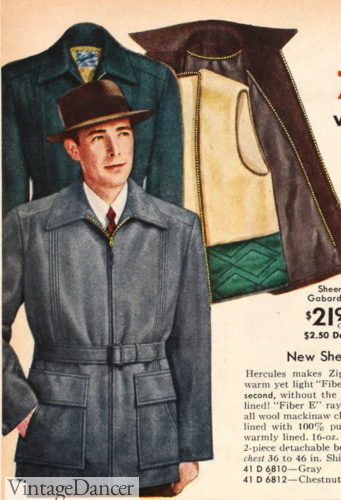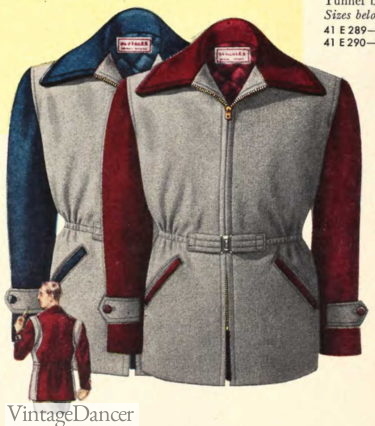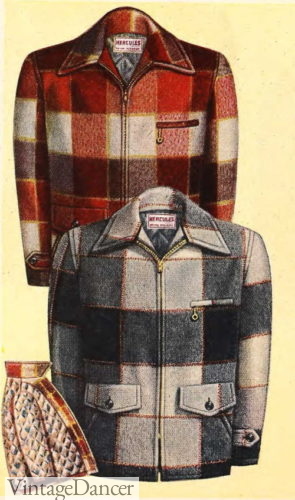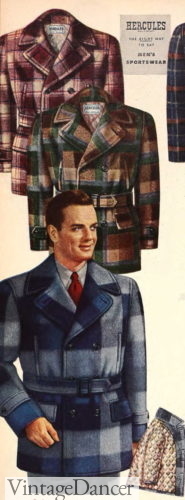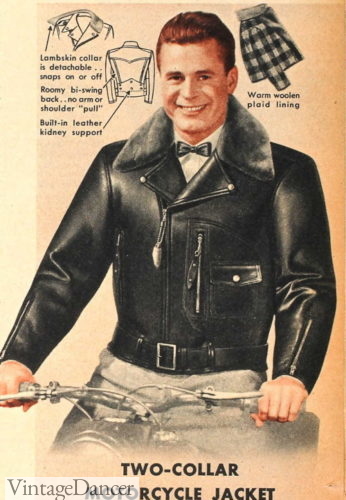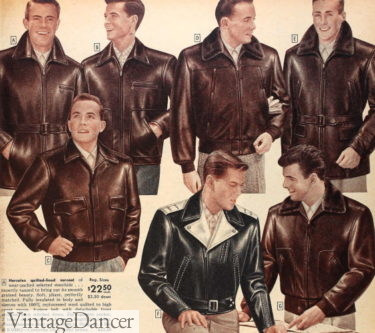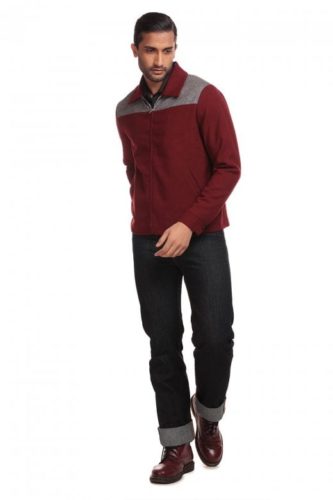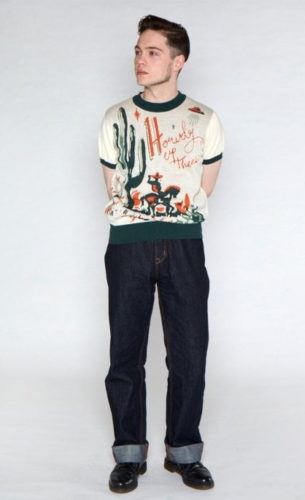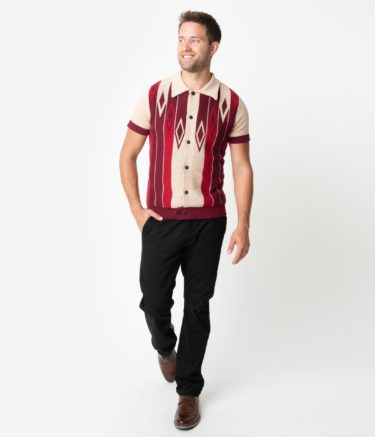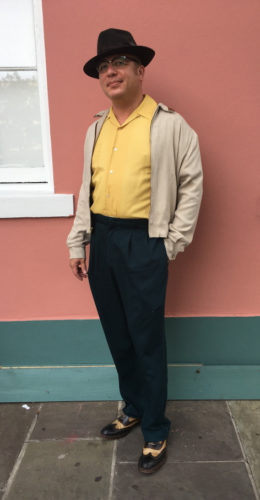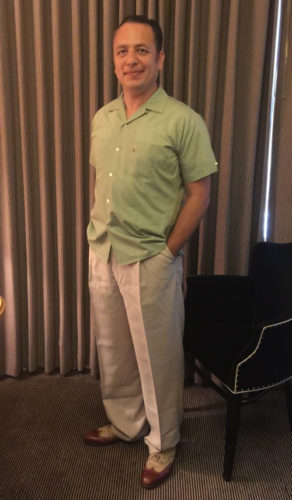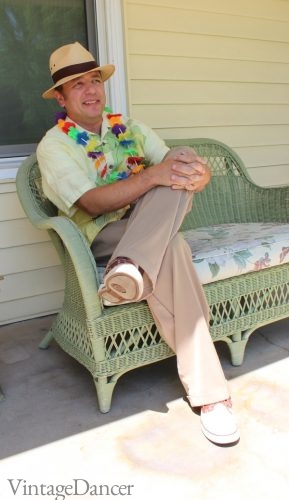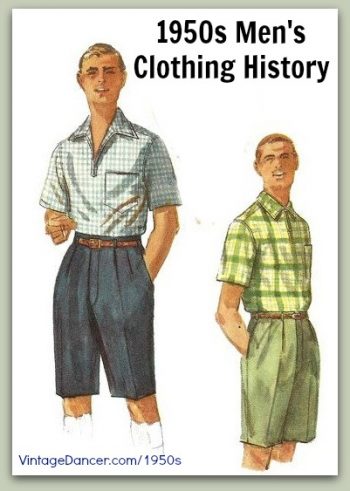
Part two of our look at men’s 1950s clothing and fashion leaves the dull grey of the workplace behind and enters the vibrant casual clothing world. Read part 1 about men’s 1950s business attire here and workwear here.
During the ‘50s, leisurewear for men became very popular. Instead of wearing three piece suits all day long, men would dress for business in the morning and quickly changed into more comfortable clothing when they returned home.
For labor workers in a uniform, many employment offices now had lockers so men could change into street clothes before heading home. Naturally, on the weekends, men wore casual clothing fit for whatever task they had: lounge clothes for at home, sport clothes for playing or viewing sporting events, and swim clothes for the beach.
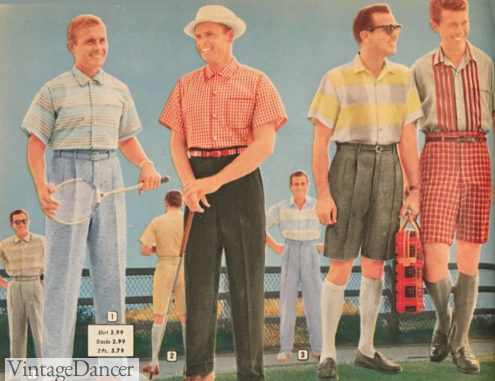
1950s Sporty, Casual Outfits
None of this is new information. Leisure clothing has been established since the 1920s. What sets 1950s men’s casual clothing apart is the sheer variety of options, the bold splash of colors, and the overwhelming use of new textures and materials. The cost of clothing plummeted after the war. New synthetic materials made clothes easy to wash and wear and the movies helped spread new fashions faster than ever before. For both men and women, the 1950s gave them options — lots of options — to wear any time of day. The diversity was most prevalent in casual clothing.
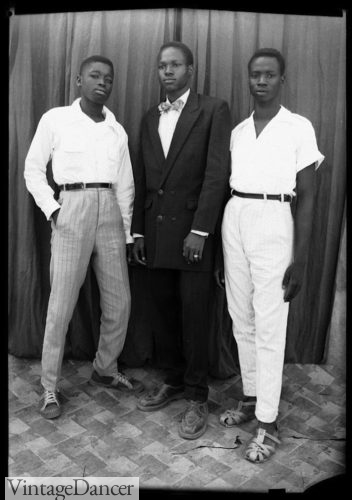
Jackets
1950s Men’s Clothing: Sport Coats
Even though men no longer wore formal business suits outside of the office, they still wore suit coats that mimicked the design. Sport coats and blazers had the same 1950s natural shoulder, straight hanging fit, two-button single breasted fronts, and flap pockets with side vents. Most 1950s sport coats also came with four-button cuffs, an element seen on business suits as well.
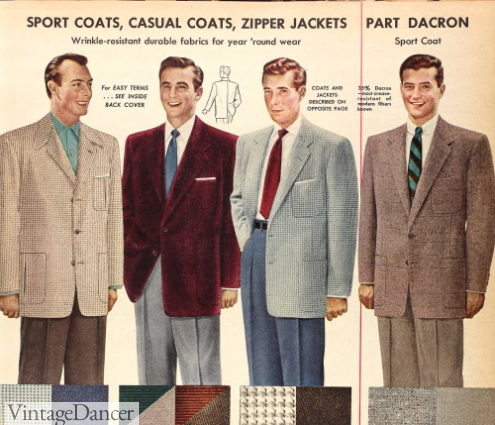
1954 Men’s Fall Sport Coats
What was different was the variety of colors and materials. For business, sport coats came in dark colors and small patterns like checks and subtle plaid. For leisurewear, the colors exploded into hunter green, burgundy red, slate blue, and charcoal grey in winter or bright blue, emerald green, silver grey, ivory, tan, teal blue, and mustard yellow in summer.
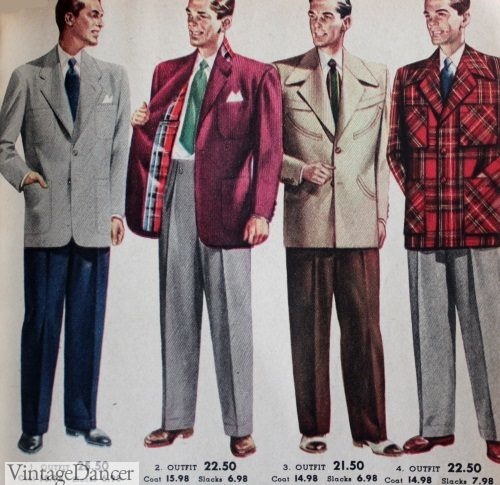
1951 Men’s Sport Coats with Plaid Linings were Very Common
Solid colors were hardly ever just solid. They usually had subtle patterns of stripes, plaid, or check. Others had rough textures of nubby tweed, blanket cloth, or corduroy. Corduroy was a major trend in the mid ’50s. Everything came in corduroy, and it came in every color imaginable.
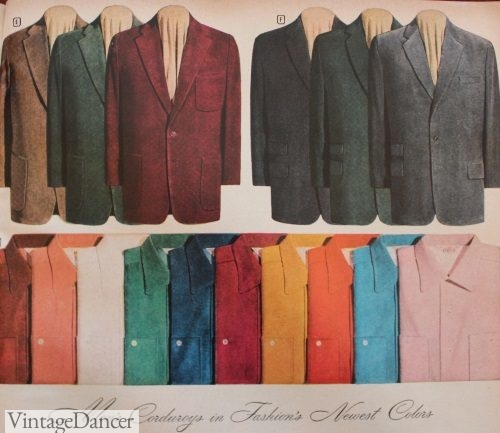
1955 Corduroy Sport Coats and Shirts
By 1957, subtle patterns were out and big patterns were in. Large plaids, big checks, deeper textures — suits got loud. Contrasting leather elbow patches, buttons, and collars were also added. Even the inside of the jacket was not ignored. Sport coat linings were often big plaids and bright colors. Something flashy was part of every sport coat design.
- 1954 Men’s Fall Sport Coats
- 1958 Men’s Summer Sport Coats
Another popular material in the mid 1950s was the jersey. Its smooth finish contrasted nicely with textured pants, and it offered quite a bit of stretch as well, making them remarkably comfortable. Jersey could be worn year round, but the most popular option for summer was Indian madras. It was a very lightweight, breathable, loose cotton weave made in colorful plaid prints (the print is on both sides of the fabric). It has a slight wave texture as well.
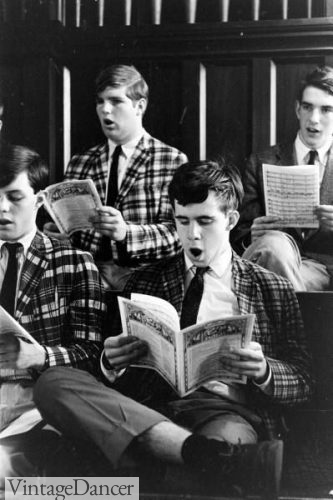
Ivy League Men in Madras Sport Coats
Texture + plaid was the perfect pairing for 1950s summer. The materials was used heavily in sport coats but also pants, shorts, shirts, and ties. Authentic madras was not inexpensive. Cheaper cotton and synthetic blends came in printed plaids that imitated real madras.
Shop classic 1950s style sport coats.
1950s Men’s Clothing: Casual Pants
To contrast with colorful, textured sport coats, men’s casual pants/trousers/slacks came in just as many if not more varieties. The general rule was to wear a textured sport coat with smooth pants, or textured pants with a smooth sport coat.
The same rules applied to colors. Patterns on top meant solid color on the bottom and vice versa. Too much texture or print was considered tacky. Matching top and bottom colors was also “too formal” for leisurewear. Colors were almost always mixed.
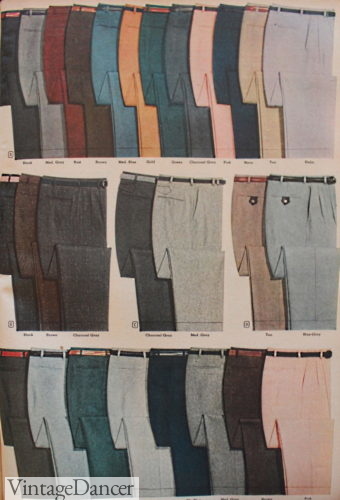
1955 Men’s Colorful Pants
1950s men’s slacks were often made of gabardine, rayon, Nylon, Dracon, cotton, linen, flannel, silk, wool, and blends of these. “Wash and wear” easy care was a major marketing slogan. In winter, heavier textured fabrics were favored such as wool tweed and corduroy.
- 1955 Cotton Pants
- 1957 Pincord Summer Slacks
Solid colors were common, as were some subtle patterns such as thin stripes, checks, and plaid. Two distinct patterns were the “flecks” and “splash” patterns found in the second half of the decade. Colors after 1954 were quite bold – pink, teal, sea-green, rust, yellow, lavender, and powder blue. Neutral shades such as light and medium grey, blues, browns, white, and tans were common throughout the decade.
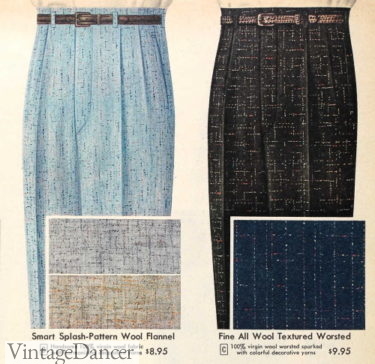
1956 Splash and Fleck Patterns
Some slacks had contrasting pocket flaps, belts, top stitching, and insert panels. These are very collectable today as part of the “atomic era” style.
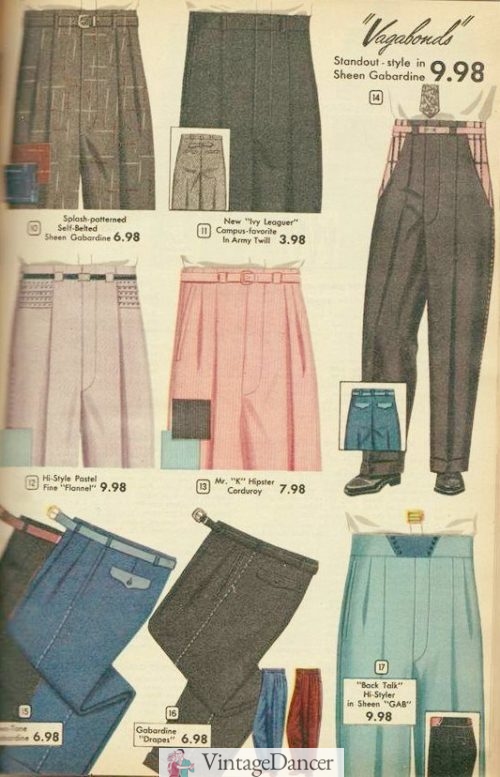
1955 Men’s Summer Trousers with Unique Waistband, Contrast Trim, and Skinny Belts
Waistbands were given new treatments in the 1950s. They continued to fit high on the waist, some slightly higher than previous decades. While most slacks were designed to be worn with thin belts, a few styles had unique belt loops, beltless waistbands, and back details:
- Self-belt – An attached belt in matching fabric. Could be full, half, or partial length.
- Continuous waistband – High waist with no waistband seam, optional dropped belt loops. Known today as the Hollywood waistband.
- Drop belt loops – Belt loops placed 1.5 to 2 inches below the waistband edge.
- Tunnel belt loops – Wide A-frame belt loops creating a “tunnel” for the belt to slide through
- Backstrap – A belt back or backstrap placed on the backside of the slacks, cinched with a slide.
- Elastic Back- Putter Pants had a wide elastic back waistband for comfort.
- 1958 Self Belt (Full) Waistband
- Continuous Waistband
- 1951 Dropped Belt Loops
- 1954 Tunnel Belt Loops
- 1957 Backstrap
- 1953 Putter Pants with Elastic Back Waistband
From the waistband down, 1950s pants fit wide and full around the hips and thighs, ending in a cuff or plain hem. After 1954, men’s pants took inspiration form Rome, where the tapered leg look was already trending. Plain or pleated waistbands were smoothed down and tapered into a long, lean, leggy look. The cuff was now only 17-1/2 inches. Pockets now had flaps and beltloops returned to standard placement.
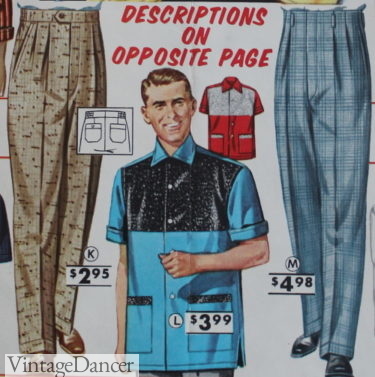
1958 Leg Men’s Pants and Bowling Shirt
As the decade inched closer to the 1960s, the pleated waistband was old news. The baggy look, too, was replaced by a more narrow, straight-leg pant. The rise was still high, but now centered at or just below the navel.
- 1959 Flat, Lean, Leggy Pants
- 1959 Men’s Casual Slacks
Most pants had belt loops and were worn with a thin leather belt. They were skinny — 3/4″to 1″ wide, sometimes less, were the standard belt widths. Thin belts with a small buckle helped keep the appearance trim and neat. Webbed nylon belts with brass buckles and even woven plastic belts were also used in summer.
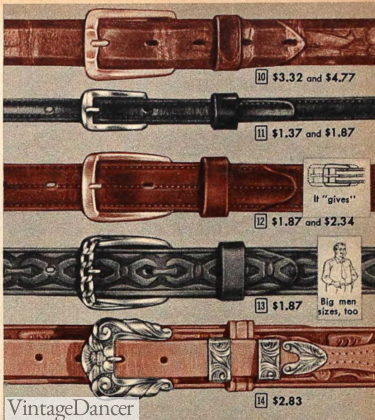
1957 Men’s Thin Belts – All 1″ or Less
1950s Men’s Shorts
“Don’t forget to wear them knee length so you don’t look like a fugitive from a baseball game. With them you’ll want knee-length socks in contrasting designs. The shoes of course should be moccasins or sports style. And wear these shorts with a swagger, lads. This is a fashion with the comfort men have been waiting for so long, and now,-in its many forms- it has entree anywhere.” Esquire, August 1956
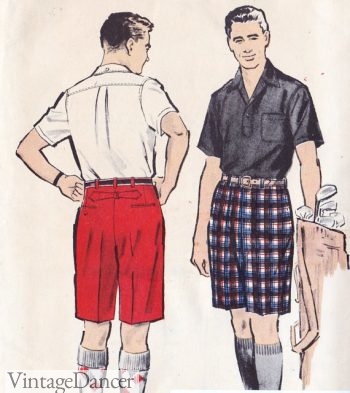
1950s Men’s Walk Shorts (Bermuda Length)
Men’s 1950s shorts were not a new invention, but they certainly gained mass market appeal starting in 1949. Beach and sport playing were the prime reasons men wore shorts prior to the 1950s. Now, it was all about casual fashion. The most popular style of short was the almost-knee length walk (walking) shorts, known as Bermuda shorts today. They fit like men’s slacks without pleats at the waistband, and hung straight down to an inch or two above the knee cap. They came in plain colors as well as plaid, seersucker, and stripes in cotton, linen, madras, and even flannel. Some had back belts and most were worn with a contrasting fabric belt.

1950s Men’s Shorts
Shorts were hardly ever worn without a pair of knee high socks, usually in bold patterns such as the classic argyle. Plain colors were OK, too. Paired with a slip on pair of penny loafers or moccasins, a man was set for a round of golf, a walk to the park, a day at the seaside, or gardening in his own backyard. Some fashionable men wore flannel shorts to dinner paired with a sport coat, shirt, and tie, especially in seaside resort towns.
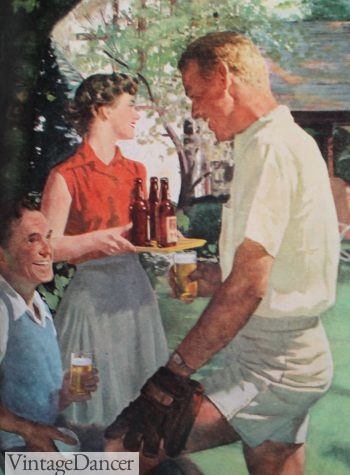
1952 Man in Short Sport Shorts
Shorts lengths changed little for most of the decade, but some specifically designed for athletic wear were even shorter. I call them men’s short shorts. : ) They hit about mid thigh, worn without a belt and made of a sturdier cotton twill. They provided maximum freedom to move and breathe and play a great game of baseball, tennis, or soccer.
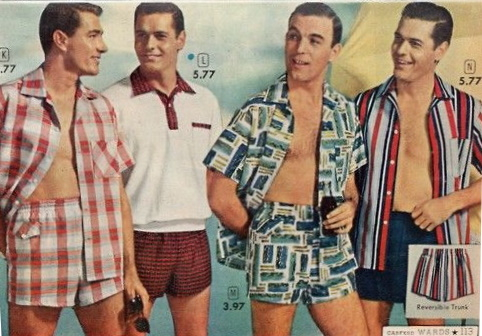
1958 Swim Shorts and Shirts Created Cabana Sets
Swim shorts were even shorter than sport shorts with flat or gathered elastic waistbands, zipper fly or side buttons, and sometimes a small flap pocket on one side. It was quite common to buy swim shorts with a matching button-down sport shirt, worn open. The brief (aka Speedo) style swim-short were another swimsuit option. Read more about men’s 1950s swimwear here.
1950s Men’s Casual Shirts
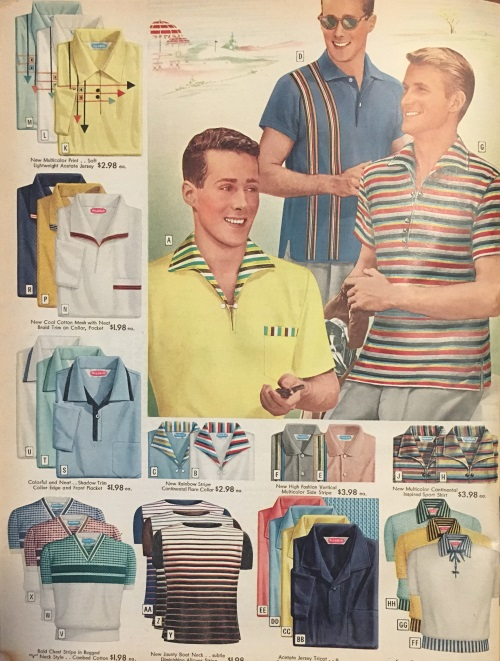
1950s Casual Shirts: Polo Shirts, T-Shirts, Zip-Down Pullovers
I have already written a detailed article on men’s shirt styles here. There were so many different styles of casual shirts for both winter and summer that they need their own article. In general, men’s casual shirts came in a few varieties: button down, knit shirt, T-shirt, Hawaiian shirt, and shirt jacket.
The button down shirt was a year round style in both long and short sleeves. Shirts came in plaid, plaid, plaid, and more plaid. Solid colors, too, but mostly just plaid. Heavy plaid fleece or wool blends for winter (Pendleton still makes them just like the ’50s cut) and light cotton or madras in summer. Most button down shirts came with either a high button collar like a dress shirt or an open neck collar. Two chest pockets with button down flaps mimicked the western look, another style of button-down shirt. Pockets could also be patch with no flaps. Besides plaid, pastels were common (pink, yellow, teal blue) as well as abstract prints, small checks (gingham), and vertical stripes.
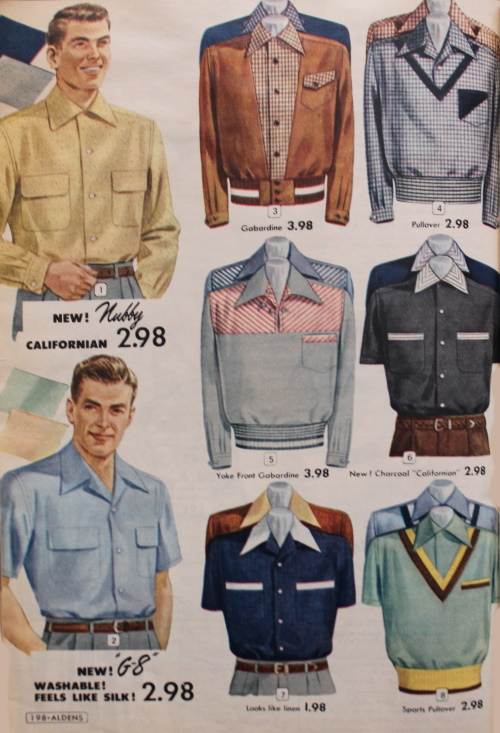
1953 Button Down Sport Shirts and Gabardine Jackets
The Hawaiian “Aloha” shirt was a classic button down shirt made of cotton and printed in abstract tropical designs. It could be worn tucked in, but when paired with casual pants and shirts, it was left untucked.
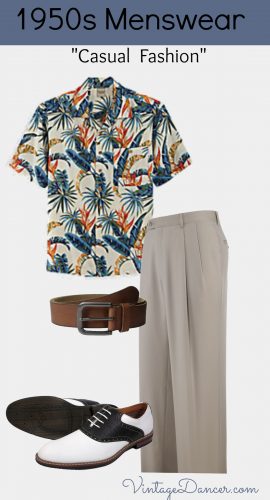
1950s Men’s Casual Summer Fashion with a Hawaiian Shirt. More menswear ideas.
Men’s 1950s knit shirts resembled a modern day polo, except the collar was much wider and contrasted with the shirt body. Some knit shirts buttoned with a single button at the neck, while others had two buttons on a placket. A few styles had a lace up placket instead of buttons– a carry over style from the 1930s. Most were pullover styles with a gathered waistband worn tucked (and sometimes not tucked) into pants.
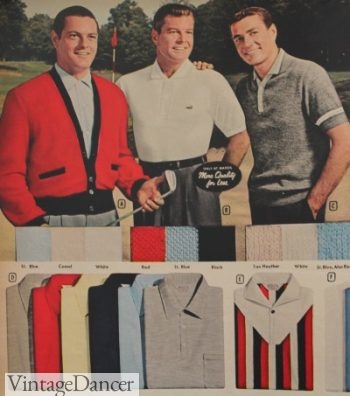
1958 Knit Shirts
The T-shirt was less common among men than it was with youth. It was made of a jersey knit and a high round collar that sometimes came in a contrasting color (modern day calls them ringer T’s). They usually had one patch pocket on the chest. Some T-shirts had novelty prints on them, but most men wore them in plain colors. They were reserved for active sportswear.

1951 white tee shirt worn by Marlon Brando in A Street Car Named Desire
Shirt jackets were a blend between the button down shirt and a long sleeve lightweight jacket. It was mostly a spring or fall item, when the weather was too cool for short sleeves but too warm for a lightweight button down shirt. They featured a wide pointed collar worn buttoned or tied with contrasting panels of stripes, checks or other western inspired print. They had one patch or flap pocket on the chest and an elastic waistband to keep the cool wind out. Sleeves buttoned at the cuff.
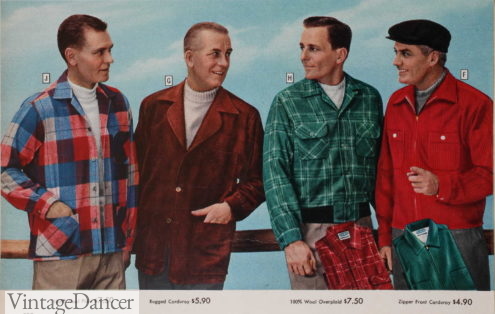
1957 shirt-jackets
The overall look was again inspired by men’s western wear. We will look at men’s western wear in this article.
Shop 1950s style men’s casual shirts.
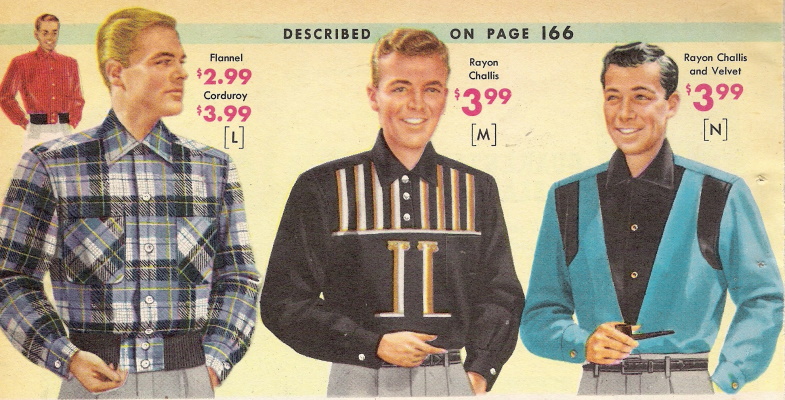
1957 men’s western influenced shirts and jacket
1950s Men’s Sweaters
Men’s sweaters increased in popularity in the early 1950s. The casual nature of the times combined with better indoor heating and AC meant men could replace jackets with a light pullover sweater or button up cardigan instead.
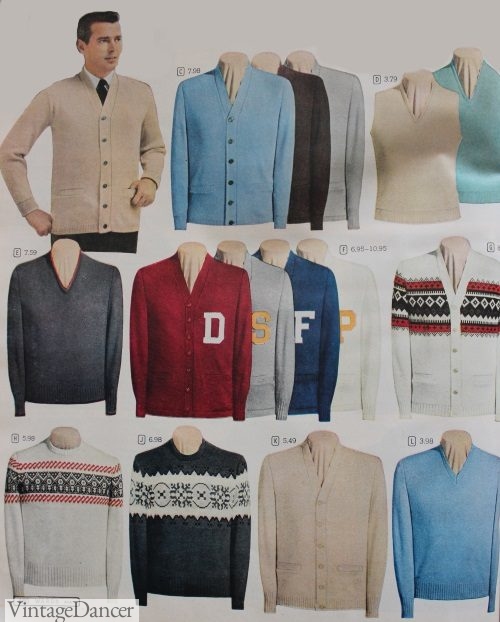
1950s Men’s Cardigans, Lettered and Winter Pullover Sweaters
While many women continued to hand knit sweaters, improvements in knitting machines made machine-made sweaters more affordable. Thanks to new synthetic fibers, sweaters were now thin, soft, and shrink-resistant. For those that could afford it, Cashmere, Alpaca, and lambswool were the best natural fibers.
Sweaters came in three weights: flat-knit was the lightest stitch, Shaker knit was a medium rib stitch, and a shell stitch was thick and fancy. Most sweaters had ribbed necklines and wide rib cuffs. The fit was straight and slim, just like jackets.
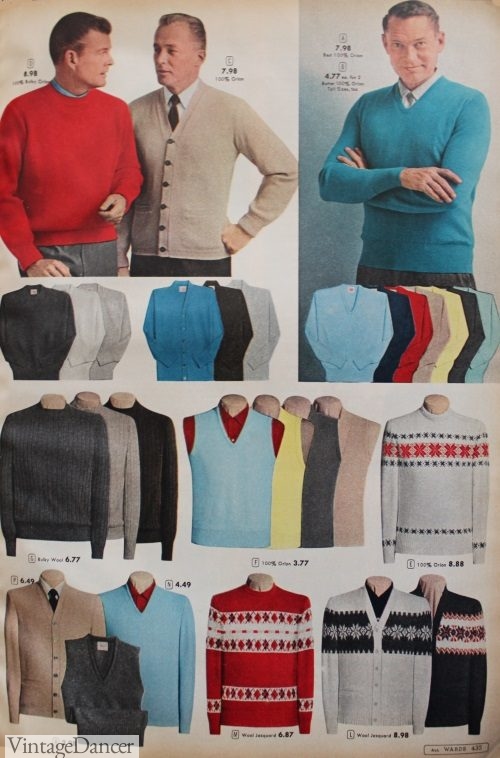
1957 Men’s Sweaters and Sweater Vests
The sleeveless V-neck sweater vest was popular with conservative men. The vest replaced the waistcoat of a 3 piece suit. Worn in plain colors over a dress shirt and tie, it was appropriate for businesswear, yet added a touch of casualness men desired. Varieties that came in bold patterns were worn over open neck sport shirts for a casual sporty look both on and off the golf course.
Button up cardigan sweaters were still classics for casual dress. The low V-neck styles could also be worn under a buttoned up suit coat or sport coat without showing, adding a layer of warmth.
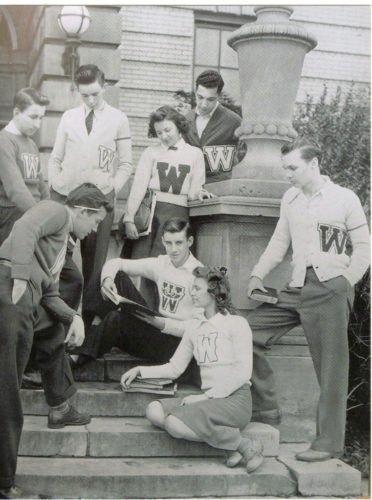
High school students wearing letter cardigans
On high school and college campuses (and worn by post college age men as well), the letterman cardigan sweater or V-neck pullover called an “Award Sweater,” “Letter Sweater,” or “Varsity Sweater” was the athletic man’s uniform. The large felt white or gold block letter on the left side represented the school name. Additional letters, stripes, and symbols were sewn onto varsity sweaters or varsity jackets to specify the sport, year, or position on the team.
Letterman sweaters were a symbol of social rank in school and a nod to the past for grown men. They have become an icon for 1950s fashion thanks to many movies about life in 1950s high schools, such as Grease. Shop letterman sweaters and jackets.
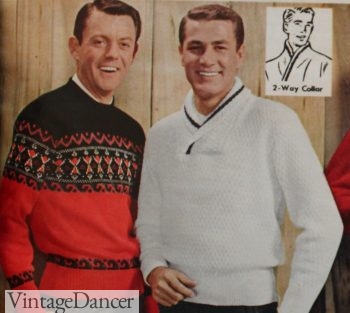
1959 Men’s Shawl Collar Sweater (R) and Ski Sweater (L)
For winter wear, the pullover sweater (sometimes cardigan style) was knit with large stripes, color blocks, and Scandinavian designs inspired by ski wear. White, red, and black were common color combinations. On the ski slopes, these sweaters were wool, thick, and quite heavy for warmth, but in the city they merely looked heavy with a wide shaker knit or shell stitch knitted loosely. Some pullover designs featured the high shawl collar that could be rolled up against the neck for more warmth or opened up for warmer climates.
Learn more about men’s vintage sweater history.
1950s Light Jackets and Coats
Men’s casual coats became very popular in the 1950s. Formal long coats and raincoats existed for business attire, but they were not needed on nights and weekends. Shorter jackets became the everyday choice for men and came in a few favorite styles with a lot of choice in materials and color. For the first time in 20th century fashion history, men’s outerwear was fashionable, not just practical. A man’s personality was expressed in the type of jacket he wore.
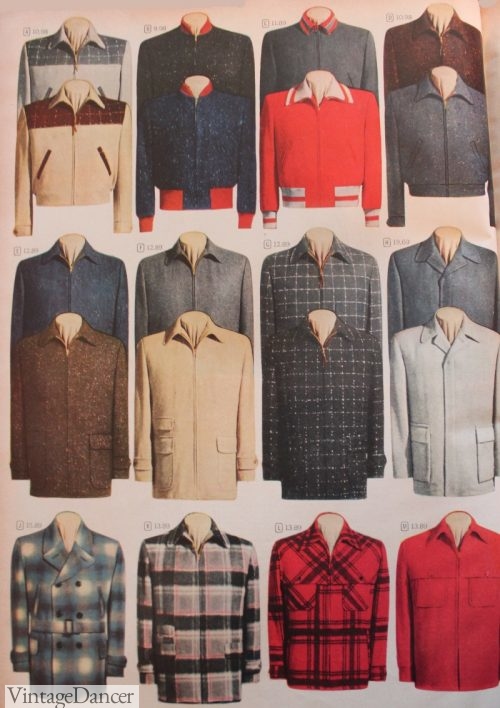
1955- Men’s Gab Jacket (Top), Fingertip coats (middle), Mackinaw Jacket and shirt-jackets (Lower)
The surcoat was the most popular in the early 1950s. It was mid hip length with a straight fitting body, fabric or fur classic collar, a yoke, and big slash or flap pockets– either two or four. The defining characteristic was the matching belt that wrapped around the waist.
- 1953 quilted lined surcoat
- 1950 two tone surcoat
The look was modeled after the Safari hunter’s jacket, popular from the turn of the century to the 1930s. This design gave way to the Norfolk-style surcoat jacket. Both designs had a quilted lining that was often removable. The jacket came in smooth leather, suede, gabardine, and synthetic blends. Color choices were endless, although brown or grey was preferred over all choices.
- 1950 wool surcoat
- 1950 Mackinaw Jackets
A similar jacket without the belt was the classic Mackinaw style. It was a rugged, outdoorsy style that usually came in heavy wool plaid or solid bright colors with a patterned quilted lining. Plain ones could be smooth or textured wool. They all had a button up or full zip-up front, classic collar, two or three large patch pockets and a with a slide belt. The design was long and straight and looked good with nearly any kind of ensemble underneath.
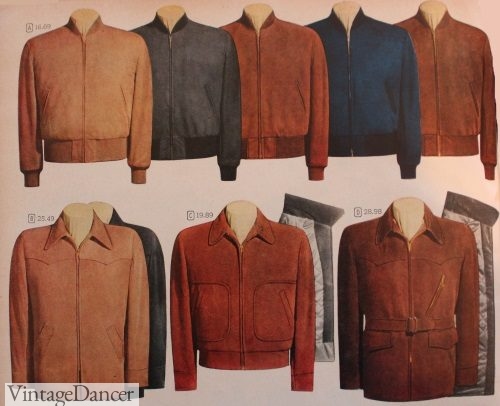
1955 Suede Bomber Jackets and other leathers
The above two styles remained popular for the entire 1950s decade and were the basic of 1960s coats as well. The long, lean lines resonated with the era. However, if we were to choose one iconic style of men’s 1950s jacket, it would be the bomber jacket. This short waisted jacket with ribbed waistband, cuffs, front zipper, slash pockets, and ribbed collar or classic point collar became trendy in the 1940s and only grew in popularity.
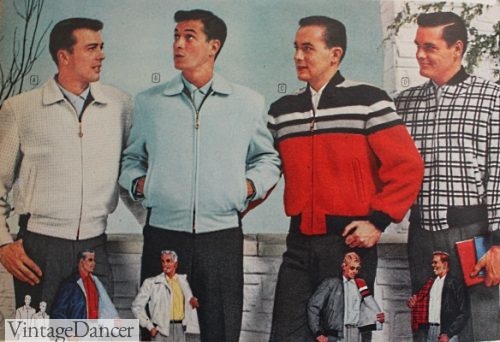
1957 gab or nylon bomber jackets
The original design was called the Eisenhower jacket, a military jacket worn by the president. Over time, the extra military pockets were lost in favor of a simpler, more streamlined look. They came in suede, leather, wool, gabardine, and even cheap vinyl and satin. Teens and college kids wore bomber jackets with school colors and chenille “Letters” on the chest.
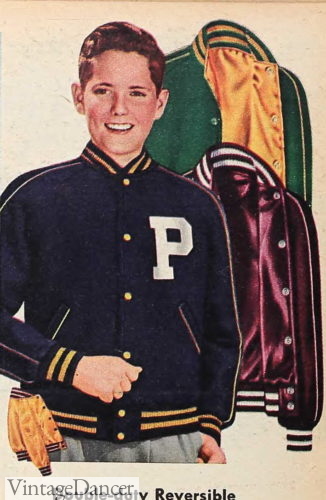
1955 varsity jackets (letter jacket)
Gabardine fabric was the best choice for a light jacket. The “Gab jacket” became a name for a similar style to the bomber jacket except with the straight hemline. They were the perfect jacket for the casual man who needed a light jacket for spring or a heavier suede jacket for fall.
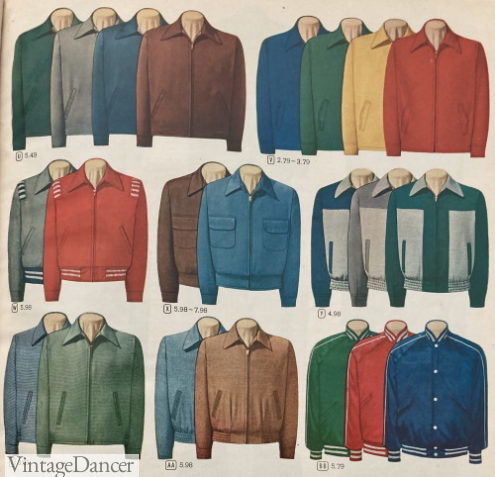
1954 gab jackets
Some Gab jackets were reversible, some had two chest pockets instead of slash side pockets, some had knit collars while most had fold out collars. Prints and pattern were trendy too in the middle to late 1950s. Diamonds, checks, argyle, colorblock and splash are just a few collectable prints.
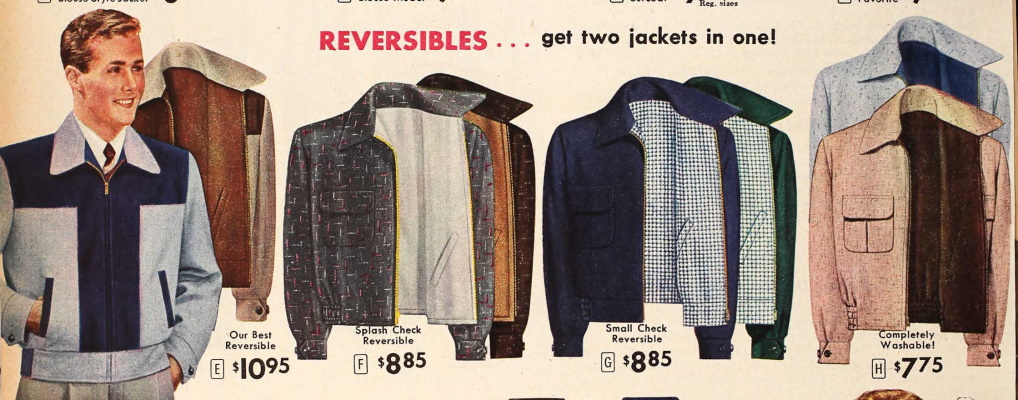
1955 spring gab jackets (semi bomber style)
Today “gab” jackets are hard to find with collars. Golf jackets, bomber jackets, and varsity jackets are more current names.
Leather or suede bomber jackets had their own fad following. Made of horsehide or cowhide in dark brown or black, almost every man who drove a car or rode a motorbike wore one. Topless convertible sport cars were the envy of every suburban man who longed to escape corporate business life on his way home. Wearing a leather jacket gave him that sense of youthful freedom. Leather made it the most windproof and durable choice as well. Zip-out linings made them easy to wash at home.
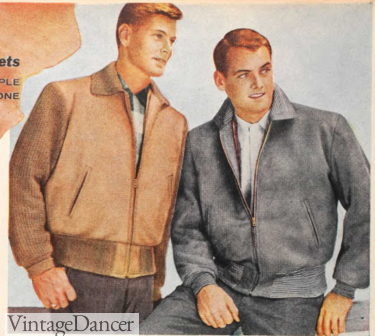
1957 suede bomber jackets
The black motorcycle jacket with off center zip, slash chest pocket, one button flap pocket, and bottom belt became associated with rebellious youth, even if they didn’t actually ride a motorcycle. For rockabilly greasers, this was the style to wear.
Leather was sued to make nearly all other style of men’s jackets such as long surcoats and shirt gab jacket styles.
- 1951 leather moto jacket
- 1955 leather jackets
Shop 1950s style jackets and coats.
1950s Men’s Casual Shoes
The final two bits of 1950s causal men’s fashion are in his accessories: shoes and a hat. Casual shoes came in many forms, mostly slip on but some lace up Oxfords with unique materials. The crepe sole, for instance, was a new casual detail that changed the shoe look from sleek to rugged.
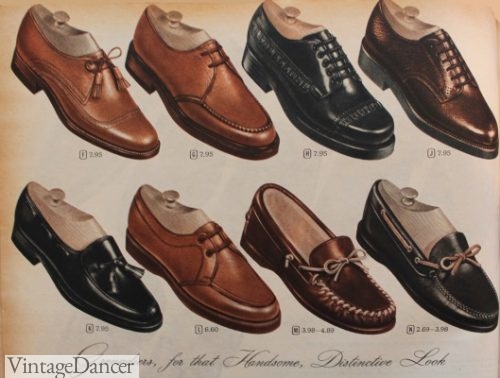
1955- Slip On Shoes- Tassel Loafers (L) and Moccasins (R)
The penny loafer, so named because a penny could be placed in the cutout piece that ran across the vamp, was daily wear for Ivy League kids. Mature men wore them as well, at home where slip on shoes were simply more comfortable. Most penny loafers were a medium brown. A few slightly more formal styles came in black or brown with a tassel tie. Some loafers came in two tones as well – snazzy!
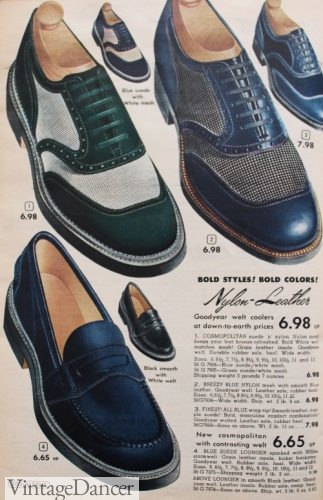
1953- Men’s Suede Shoes
The moccasin was another favorite slip on. Black or brown were equally popular with contrast stitching and a bow tie. For at home, moccasin slippers in white or tan were soft yet dressy enough to be worn in company.
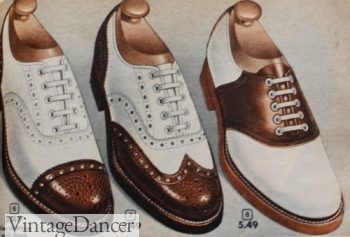
1952 From Right to Left – Men’s Saddle Shoe, Wingtip, and Cap Toe Two Tone Shoes
Saddle shoes, those iconic black and white lace up shoes associated with teens, were still very common since their debut in the 1920s. In the 1950s, we saw more color combinations, such as blue and white, grey and white, brown and white, and brown and tan. Mature men hardly wore them, but they did wear other vivid colors for lace up Oxfords. Blue suede shoes were not only the topic of a popular Elvis song but were also popular casual men’s shoes. Why blue? I couldn’t find the answer. Maybe blue was the new black? It was not followed by other colors (some green), although textures were plentiful: embossed leather like heavy reptile skin, corduroy, rough suede, woven canvas, and even printed plaid. Textured shoes, both lace up and slip on style, were big fashion items for trendy fashionable men.
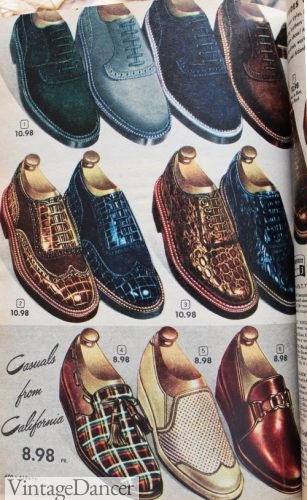
1952- Textured Shoes in All Styles
Sport shoes, worn for actually playing sports, continued to have their place in footwear history. The styles didn’t change drastically from the turn of the century. The high top Converse shoes remained popular among basketball wearers– this time with a crepe sole, ventilating eyelets, and a rubber cap toe. Black and white canvas high tops were still the best choice for athletes while low tops in white, brown or blue were worn year round for the ultimate in sporty casualness.
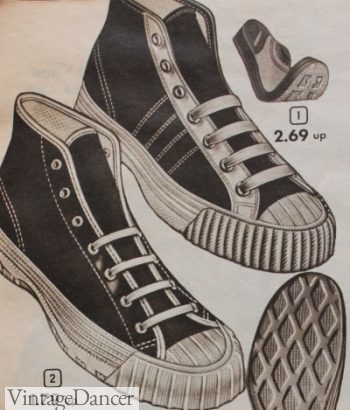
1953 Converse Style Sport High Tops
There are quite a few more, less common, styles of shoes for both dress and casual wear to look at. Read this article for more information.
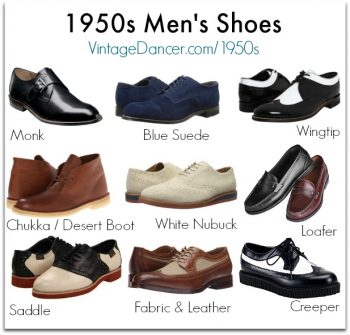
1950s Men’s shoe styles you can buy today. Shop now.
1950s Men’s Casual Hats
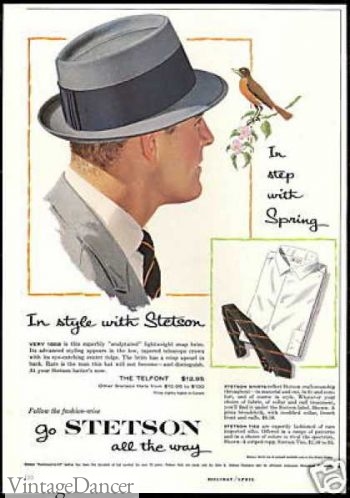
1950s Men’s Hat
Men’s hats were mostly worn with business attire and dressy summer clothing. The fedora hat was the most classic with a narrow brim tapered down in the front and up at the back. Similar shapes such as the pork pie (round crown), Panama (center crease), and walking hat (a bucket hat) all had the same ’50s tilt and wide, usually contrasting hat band. Newer band styles in the late ’50s were thin felt or leather bands.
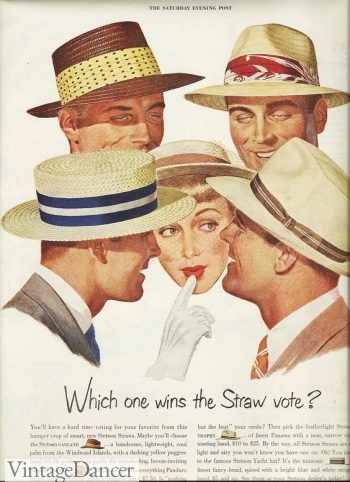
1950s Men’s Straw Hat Styles
There was not much difference between formal hats and casual hats. In summer, all major hat styles came out in a straw version but with a slightly wider brim. In the 1950s, the hat band took on more personality with printed fabrics in tropical themes. Madras plaid, silk shantung and striped prints made their way onto straw hats.

1950s Men’s Sport Caps
The sportiest hat was the cap. It was casual, light and simple. Popular on collage campuses as well as with mature men, caps came in the classic slightly floppy shape or the more oval shape with stiff brim. All textures were made into caps such as nubby tweed for winter, wool plaid for fall, smooth silk for spring, and breathable cotton for summer. Some even had contrasting trim on the edges and brim.
Read more detail about men’s 1950s hats style here. Shop for men’s hats as well.
1950s Men’s Casual Outfit Ideas
- Collectif, knitted shirt and jeans
- Everyday 1950s
- Date Night
Top row: Three looks from Collectif menswear 1950s and 1960s clothing line of shirts, jeans and jackets.
Bottom row: Outfits Oscar wears using a mix of genuine vintage and reproduction 1950s clothing.
Your 1950s Style Clothing
Begin your 1950s wardrobe with these links:
1950s men’s shirts– Camp, bowling, knit, Hawaiian, T shirts and polo shirts.
1950s men’s pants and shorts – Dress slacks to casual jeans and classic shorts
Men’s vintage style sweaters and sweater vests
1950s men’s jackets and coats– Letterman jackets, gab jackets, leather biker jackets, and long car coats
1950s men’s style shoes – Sporty oxfords, casual loafers, sneakers and sandals.
1950s style men’s hats– Summer straw fedora hats, flats caps and more in the 1950s style
Vintage reproduction clothing brands – Browse the BIG list of men’s clothing brands that re-make 1950s men’s clothing
Need more help? Ask us anytime.
Read More
- 1950s Menswear Outfit Ideas
- 1950s Men’s Outfit Inspiration | Clothing Ideas
- Men’s Business Attire in the 1950s
- 1950s Men’s Workwear and Casual Clothes
- The Styles of 1950s Men’s Hats
- 1950s Men’s Shoe Styles, from Rebel to Rockabilly
Debbie Sessions has been teaching fashion history and helping people dress for vintage themed events since 2009. She has turned a hobby into VintageDancer.com with hundreds of well researched articles and hand picked links to vintage inspired clothing online. She aims to make dressing accurately (or not) an affordable option for all. Oh, and she dances too.
